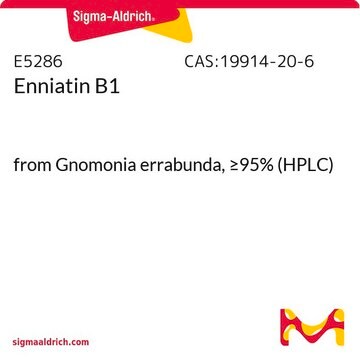32609
Sterigmatocystin
Sinónimos:
3a,12c-Dihydro-8-hydroxy-6-methoxy-7H-furol[3′,2′:4,5]furo[2,3-c]xanthen-7-one
About This Item
Productos recomendados
grado
analytical standard
reference material
fabricante / nombre comercial
Manufactured by: Sigma-Aldrich Production GmbH, Switzerland
técnicas
HPLC: suitable
gas chromatography (GC): suitable
aplicaciones
cleaning products
cosmetics
food and beverages
personal care
formato
neat
temp. de almacenamiento
−20°C
cadena SMILES
COc1cc2OC3OC=CC3c2c4Oc5cccc(O)c5C(=O)c14
InChI
1S/C18H12O6/c1-21-11-7-12-13(8-5-6-22-18(8)24-12)17-15(11)16(20)14-9(19)3-2-4-10(14)23-17/h2-8,18-19H,1H3
Clave InChI
UTSVPXMQSFGQTM-UHFFFAOYSA-N
¿Está buscando productos similares? Visita Guía de comparación de productos
Descripción general
Aplicación
- Grain samples by high-performance liquid chromatography-electrospray positive ionization-tandem mass spectrometry (HPLC-ESI+-MS/MS).
- Sweet pepper samples by LC-ESI+-MS/MS.
Acciones bioquímicas o fisiológicas
Palabra de señalización
Danger
Frases de peligro
Consejos de prudencia
Clasificaciones de peligro
Acute Tox. 3 Oral - Carc. 2
Código de clase de almacenamiento
6.1C - Combustible acute toxic Cat.3 / toxic compounds or compounds which causing chronic effects
Clase de riesgo para el agua (WGK)
WGK 3
Punto de inflamabilidad (°F)
Not applicable
Punto de inflamabilidad (°C)
Not applicable
Equipo de protección personal
Eyeshields, Faceshields, Gloves, type P2 (EN 143) respirator cartridges
Choose from one of the most recent versions:
¿Ya tiene este producto?
Encuentre la documentación para los productos que ha comprado recientemente en la Biblioteca de documentos.
Nuestro equipo de científicos tiene experiencia en todas las áreas de investigación: Ciencias de la vida, Ciencia de los materiales, Síntesis química, Cromatografía, Analítica y muchas otras.
Póngase en contacto con el Servicio técnico







